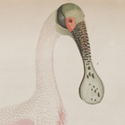Wilson's Ornithology
In 1807 Alexander Wilson called at the Library Company to solicit a subscription for his American Ornithology (Philadelphia, 1808-1814), the first American scientific work illustrated with color plates. The Librarian signed up for not one but three copies, becoming not merely a purchaser but a patron.
This was the first color-plate book purchased since Catesby, and again it was an essential purchase, a book that was truly useful as well as beautiful.
Wilson has often been called “the father of American ornithology.” This Scottish weaver turned poet emigrated to Philadelphia in 1794 and immediately became fascinated by the bird life of America. With encouragement and instruction from his neighbor the naturalist William Bartram, he began to draw the birds he saw. The engraver Alexander Lawson transferred the drawings to copper plates, and a group of young mostly female artists colored the prints by hand.
Wilson traveled widely in search of new specimens and subscribers for the book, projected to be 120 plates in ten volumes. But as the work grew larger, his money ran out, and unable to pay the artists, he did most of the coloring himself. He died exhausted by his labors in 1813, at age 47.
Scientifically, his work is astonishingly complete and accurate; his text is still useful and readable.
 Alexander Wilson and Alexander Lawson. “Roseate Spoonbill,” Plate LXIII in American Ornithology, Volume VII. Philadelphia: Bradford and Inskeep, 1813. Purchased by subscription, 1807.
Alexander Wilson and Alexander Lawson. “Roseate Spoonbill,” Plate LXIII in American Ornithology, Volume VII. Philadelphia: Bradford and Inskeep, 1813. Purchased by subscription, 1807.
Our extravagance in subscribing for three copies of Wilson’s book was recently justified when side-by-side comparison of different states of the plates revealed that Wilson and his engraver Alexander Lawson occasionally used color printing to supplement hand coloring in small areas of some copies of some plates. This is the same kind of color printing used on the Holbein portrait: the pink and black inks were daubed onto the copper plate by hand with each impression pulled. (Click here for detail view.) Wilson mentioned his experiments in color printing in a letter of 1810 to William Bartram and in the preface to his fourth volume in 1811, but the actual color printing has never been noticed. It now appears that this was the first American book with plates printed in more than one color.